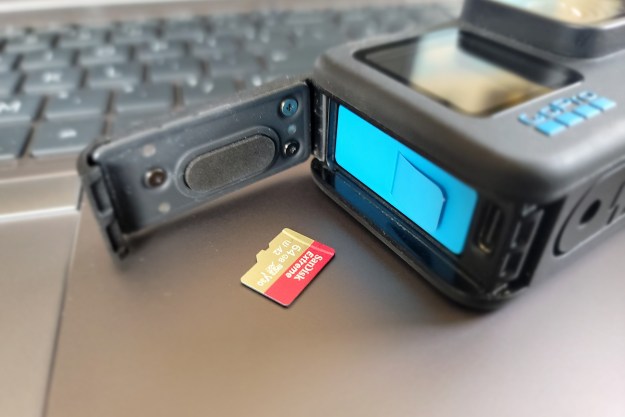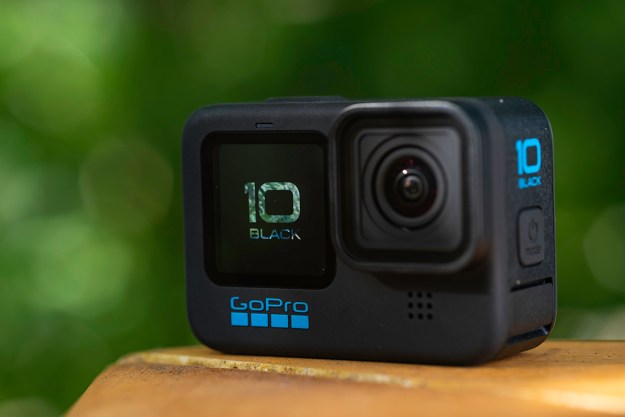GoPro’s six-camera rig has made its official debut at the 2016 NAB conference. Designed to capture 360-degree videos that can be used for virtual reality experiences, the spherical array, called the Omni, is now available for pre-order at $5,000 for a complete package. The Omni has an availability date of August 17.
First teased during last year’s Re/code’s Code conference and announced last week, the Omni is a rig outfitted with six GoPro Hero4 Black action cameras — all synced to capture what becomes a 360-degree video. Because each Hero4 Black can shoot up to 4K, the final product is a video with resolutions at up to 8K; you can view the high-resolution video through a headset, or downscale it for desktop viewing on YouTube. To handle the stitching, GoPro includes Kolor Software, a VR startup it acquired last year.
Here’s a typical Omni workflow: After a video is shot (or videos, rather), the content is sent to a computer via the Omni Importer, which lets the user preview, manage, and render the footage. Kolor Autopano Video is used for “fine-tuning,” and the final product is proofed via the GoPro VR player and published on the GoPro VR website or free mobile app. GoPro is also working with Adobe to give pro users precision editing via Premiere Pro CC and After Effects CC, which can natively handle 360-degree video at 8K, GoPro says. (Adobe recently announced 360/VR support in the latest version of Premiere Pro CC).
Besides the rig and six Hero4 Black cameras, the full Omni package includes Kolor software license, six batteries, a GoPro Smart Remote (to initiate synchronized recording, although that can also be done via the GoPro smartphone app), six Mini USB cables, six 32GB MicroSD cards and card readers, and case.
If you want just the rig, it will cost you $1,500, and you’ll need to supply your own cameras and editing software. This is ideal for those who already own Hero4 cameras and utilize software like Premiere Pro CC.
While $5,000 puts it out of casual use among ordinary consumers, it’s an attractive price for VR enthusiasts or budding filmmakers, particularly those who want a complete setup, without needing to cobble one together using different parts (although there are less-expensive rigs designed to do the same thing, but you’ll still need the stitching software). The Omni is a considerable bargain when compared to GoPro’s pro-centric Odysssey, a stereoscopic capture system that uses 16 Hero4 Black cameras and designed for Google’s VR Jump platform; this rig costs $15,000.
GoPro says the Omni is designed for capturing sporting events, museum and tourism installations, hotel and real estate tours, and educational tutorials, which puts the Omni toward the consumer end while the Odyssey is geared toward high-end productions (you can see examples at the GoPro VR portal). It’s also possible that this rig could be designed for drone use, considering GoPro is developing one, called the Karma.
It will be interesting to see the quality difference between a 16-camera rig and a six-camera version, although it should be considerable higher than single or dual-sensor cameras. There’s also no mention about YouTube or Facebook support, or about sound quality; the Hero4’s onboard mic isn’t the best, and audio is an important part of an immersive VR experience (the Odysssey supports external mics). GoPro is presenting various VR solutions at NAB this week, including the Odyssey and the launch of the aforementioned GoPro VR platform, which is available on the Web, and for iOS and Android devices. GoPro VR will be a place for users to host and share their 360-degree captures, much like the existing GoPro Channel for non-panoramic videos.
Editors' Recommendations
- The 15 best GoPro accessories in 2024
- I tried to replace my GoPro with this new phone and its clever camera
- GoPro Hero 11 Black leak suggests a moderate upgrade
- GoPro takes to the skies with the Hero10 Black Bones
- ReelSteady makes GoPro Player ‘reel’ useful for filmmakers


